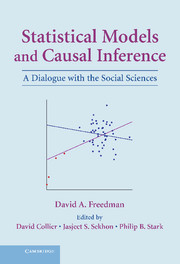Book contents
- Frontmatter
- Contents
- Preface
- Editors' Introduction: Inference and Shoe Leather
- Part I Statistical Modeling: Foundations and Limitations
- Part II Studies in Political Science, Public Policy, and Epidemiology
- Part III New Developments: Progress or Regress?
- Part IV Shoe Leather Revisited
- References and Further Reading
- Index
Preface
Published online by Cambridge University Press: 05 June 2012
- Frontmatter
- Contents
- Preface
- Editors' Introduction: Inference and Shoe Leather
- Part I Statistical Modeling: Foundations and Limitations
- Part II Studies in Political Science, Public Policy, and Epidemiology
- Part III New Developments: Progress or Regress?
- Part IV Shoe Leather Revisited
- References and Further Reading
- Index
Summary
David A. Freedman presents in this book the foundations of statistical models and their limitations for causal inference. Examples, drawn from political science, public policy, law, and epidemiology, are real and important.
A statistical model is a set of equations that relate observable data to underlying parameters. The parameters are supposed to characterize the real world. Formulating a statistical model requires assumptions. Rarely are those assumptions tested. Indeed, some are untestable in principle, as Freedman shows in this volume. Assumptions are involved in choosing which parameters to include, the functional relationship between the data and the parameters, and how chance enters the model. It is common to assume that the data are a simple function of one or more parameters, plus random error. Linear regression is often used to estimate those parameters. More complicated models are increasingly common, but all models are limited by the validity of the assumptions on which they ride.
Freedman's observation that statistical models are fragile pervades this volume. Modeling assumptions—rarely examined or even enunciated—fail in ways that undermine model-based causal inference. Because of their unrealistic assumptions, many new techniques constitute not progress but regress. Freedman advocates instead “shoe leather” methods, which identify and exploit natural variation to mitigate confounding and which require intimate subject-matter knowledge to develop appropriate research designs and eliminate rival explanations.
- Type
- Chapter
- Information
- Statistical Models and Causal InferenceA Dialogue with the Social Sciences, pp. xi - xiiPublisher: Cambridge University PressPrint publication year: 2009

